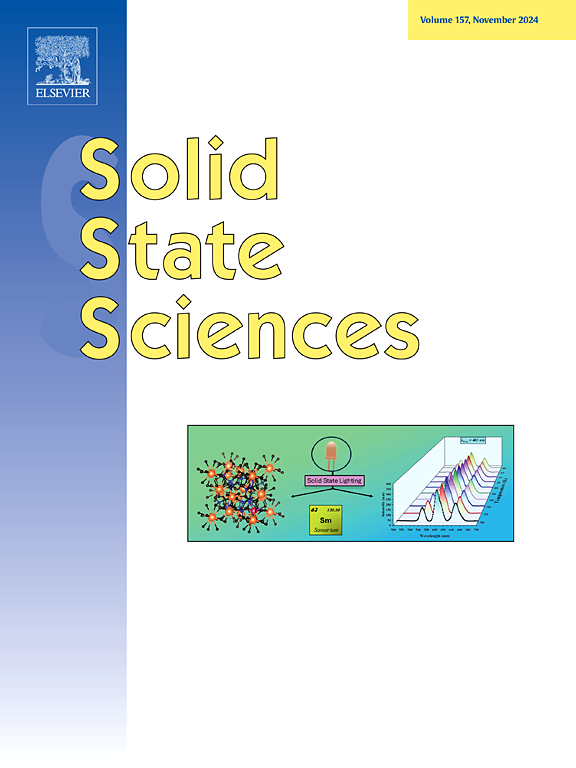Crystal growth, thermal, optical, magnetic and electrochemical properties of Mo2Ta2O11
IF 3.3
3区 化学
Q2 CHEMISTRY, INORGANIC & NUCLEAR
引用次数: 0
Abstract
Single crystals of the transition metal oxide Mo2Ta2O11 were grown for the first time using molten flux synthesis. The compound crystalizes in the trigonal space group R (no. 166) with lattice parameters a = b = 5.6267(1) Å and c = 25.1424(6) Å and a unit cell volume of 689.36(3) Å3. The structure of Mo2Ta2O11 is composed of alternating layers of TaO6 octahedra and MoO4 tetrahedra connected via corner-sharing. CaH2 was used to achieve a partial low temperature reduction of Mo2Ta2O11. The electrochemical lithiation of polycrystalline Mo2Ta2O11 was also investigated for the first time. Mo2Ta2O11 underwent a structural rearrangement while maintaining a reversible capacity of ∼150 mAh/g.

Mo2Ta2O11的晶体生长、热、光、磁和电化学性能
本文首次采用熔剂合成方法制备了过渡金属氧化物Mo2Ta2O11的单晶。化合物在三角空间群R 3中结晶,m (no。晶格参数a = b = 5.6267(1) Å, c = 25.1424(6) Å,单元胞体积为689.36(3)Å3。Mo2Ta2O11的结构是由ta6八面体和mo4四面体通过共享角连接而形成的交替层组成。用CaH2实现了Mo2Ta2O11的部分低温还原。本文还首次研究了多晶Mo2Ta2O11的电化学锂化过程。Mo2Ta2O11进行了结构重排,同时保持了约150 mAh/g的可逆容量。
本文章由计算机程序翻译,如有差异,请以英文原文为准。
求助全文
约1分钟内获得全文
求助全文
来源期刊

Solid State Sciences
化学-无机化学与核化学
CiteScore
6.60
自引率
2.90%
发文量
214
审稿时长
27 days
期刊介绍:
Solid State Sciences is the journal for researchers from the broad solid state chemistry and physics community. It publishes key articles on all aspects of solid state synthesis, structure-property relationships, theory and functionalities, in relation with experiments.
Key topics for stand-alone papers and special issues:
-Novel ways of synthesis, inorganic functional materials, including porous and glassy materials, hybrid organic-inorganic compounds and nanomaterials
-Physical properties, emphasizing but not limited to the electrical, magnetical and optical features
-Materials related to information technology and energy and environmental sciences.
The journal publishes feature articles from experts in the field upon invitation.
Solid State Sciences - your gateway to energy-related materials.
 求助内容:
求助内容: 应助结果提醒方式:
应助结果提醒方式:


